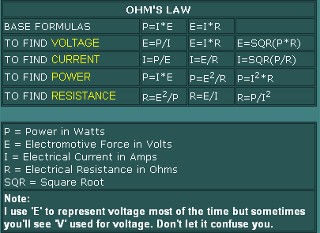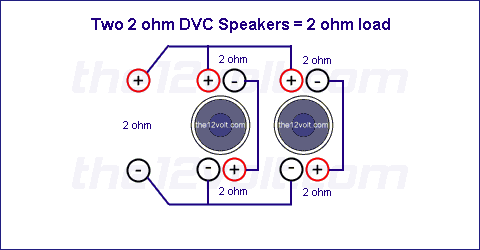hey, i have 2 dvc 2ohm subs if i wire them parallel is 0.5 ohms right, now i asked some one and they told me that there is a difference to that depending on the amp you connect it to i have a 1 ohm stable amp so im lost now lil help thanks
-------------
.:CHICAGO:STUNZ:.
i recommend that you series each of the voice coils on each of your woofers so that each speaker would read 4ohms on a DMM. Than parrellell the two speakers together which would bring your final impedance to 2ohms which will let your amp run cooler and maybe allow the woofers to make it to Valentines Day! Hey good luck...
-------------
remarkable53
You're asking how Ohm's Law fits in with how you wire the subs? When you wire the subs and connect them to the amplifier, you've placed an impedance load on the amp. It is that impedance load that will enable the amplifier to produce power; no load = no output. That's where Ohm's Law comes into play. Ohm's Law describes how the electrical forces power, resistance (impedance), current and voltage interact with each other. These are steadfast, unchangeable physical laws.

In the chart you can see that the base formulae describe these interactions of the four forces. P = I X E and E = I X R. The groups of formulae listed below those are variations of those basics that will specifically lead you to an answer you might be looking for.
With your wiring concern, the amount of impedance load you wire those subs to will cause the amplifier to work in a specific way. It is rated, that is, built for and tested to produce a limited amount of current. All electrical devices have limitations. A 1/2 ohm resistive load would cause it to produce more current 'I' than it was built to handle and so it would shut off or burn up trying to produce it. Its 'R' limit is 1 ohm at the extreme limit and will accept any load at 1 ohm or higher. That's why, with the subs you have, the lowest wiring impedance option is 2 ohms.
-------------
Build the box so that it performs well in the worst case scenario and, in return, it will reward you at all times.
I was just reading your response and out of courisity what would the effect be if the resistance was lower ie say 12ohm or 16?? would the lesser loading damage the amp or speaker. thanks
less power out of the amp...
The only time a solid state amp will be damaged by speaker loading is if the total impedance is too low. Then it can overload the amplifier. Higher impedance loads are never a problem for SS amps. Speaker do not care as long as you do not overpower them.
-------------
Support the12volt.com
 the12volt •
the12volt • 